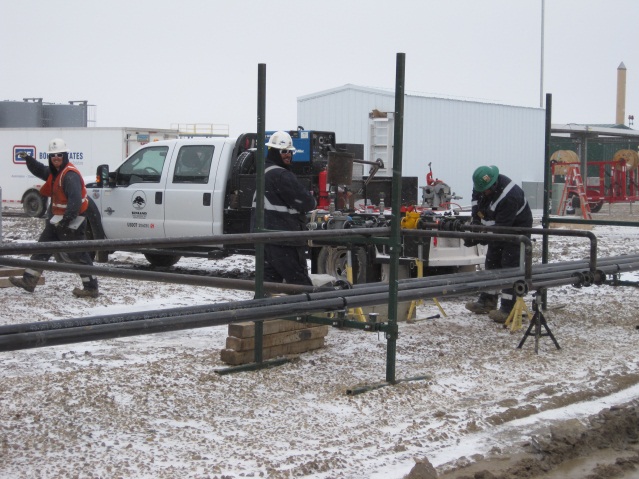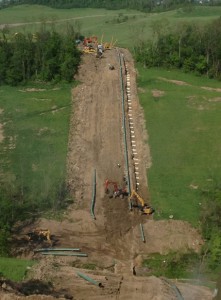November 2013, Vol. 240 No. 11
Features
Family-Owned Sunland As Diversified As Construction Companies Get

You might say Craig Meier started at the ground level on the road to becoming president of Sunland Construction, Inc., working as a roustabout for several small contractors, while earning his mechanical engineering degree from the University of Oklahoma.
Considered to be one of the industry’s hardest working executives, Meier heads one of the industry’s most diversified family-owned construction companies, with expertise in pipeline installations in the difficult marsh and marine landscape of the Gulf Coast. However, despite his management experience, which includes 12 years at CenterPoint and 15 years at Sunland, he is quick to credit those in the field as real mentors in providing him with “so much knowledge and practical experience.”
During his tenure with Eunice, LA-headquartered Sunland, which began in 1999 when he became vice president, Meier has seen the company not only offer pipeline and facilities services, but also provide expertise in directional drilling, distribution and field services. In 2003, Sunland became involved in its first LNG project – the regasification of Cove Point in Maryland. As the shale revolution took off, Sunland, which already had a presence in most of the production areas in the Lower 48, began focusing on unconventional shale plays, launching Sunland Field Services.
In addition to his work with Sunland, Meier will be chairman of the INGAA Foundation in 2014, an organization which represents the interests of companies that work with interstate natural gas transmission operators in North America.
In this interview, Meier touches on adapting to the shifting energy landscape, the challenges of attracting and mentoring employees who want to stay on board for the long haul and the special challenges posed by some of Sunland’s vast array of projects.

P&GJ: How did you end up in the oil and gas industry, and eventually at Sunland? Were there any mentors or role models along the way?
Meier: After working summers for various small contractors doing roustabout type work, while attending college at the University of Oklahoma, I had an opportunity to take a 50% pay cut one summer from my roustabout position and become a summer intern engineer for Arkla (now CenterPoint/Engage) in Oklahoma City. At the end of summer, they offered me a regional engineer position when I completed my degree in mechanical engineering. I worked in various engineering and management positions during my 12 years at CenterPoint.
There were several folks who were instrumental in my development, but the key people that really mentored me were the ones that had been out in the field for 20 plus years. They had so much knowledge and practical experience that I did not have. I quickly found the more I could help them and make them successful, the more they would help me, and the more successful I would be. In January 1999, I had an opportunity to leave CenterPoint as their director of Engineering and Construction and to help grow a family-owned company, Sunland Construction, Inc. as their vice president.
P&GJ: About three years ago, Sunland began targeting unconventional shale plays as the key area for growth. What was behind that decision?
Meier: We have always had a presence in most of the production areas in the Lower 48 of the U.S. (Barnett, San Juan, Piceance, etc.), but with the shale plays becoming so prolific, we put a strategy together to focus on the unconventional shale plays by starting Sunland Field Services.
P&GJ: What are some of the rewards and challenges that the shale boom has brought to the pipeline industry?
Meier: The rewards are simple. There is a lot of work that is needed to be done in a short time frame and the producers and midstream companies are looking for good, qualified contractors to do it. The main challenges in most of the shale plays are the logistics of finding qualified people (local or bringing them in) and living arrangements (areas that are not ready for thousands of people need hotels and trailer parks). The working conditions are not always ideal, but through a commitment to safety, quality and customer satisfaction, our employees continue to help bring our nation closer to energy independence.
P&GJ: How much has Sunland grown over the last several years? How much of that can you attribute to the shale boom?
Meier: Sunland has steadily grown since the early 2000s with diversified services, organic growth and strategic acquisitions. We offer construction and related services for pipelines, facilities/stations, integrity (recoating, hydrostatic testing, composite sleeves, etc.), directional drilling, Buffalo Gap I&E (instrumentation and electrical), distribution, DHB (casing seals), Kori (manufacture of amphibious undercarriages for trackhoes and personnel carriers), and now our field services groups (roustabout, well pad, dirt work, lease roads, tank batteries, well hookups, etc.). This allows clients to have a one-stop shop for all of their construction service needs.
The unconventional shale plays have been a big part of our growth strategies, starting with the Barnett Shale in 2005 (all natural gas) to the Bakken, Eagle Ford and Utica (oil and liquid hydrocarbons).

P&GJ: Sunland is in the Barnett, Haynesville, Eagle Ford, Marcellus, Bakken and Utica shales. Which of those is the company concentrating on most heavily? Why?
Meier: All of them, you never know exactly which one and which year is going to have the most opportunities.
P&GJ: Have any of these shale plays either proved to be pleasant surprises for Sunland or, conversely, not worked out as well as the company had hoped?
Meier: The shale plays are what they are, which follows commodity prices. So, as the price for natural gas goes down, so does drilling activity. And, as the price of oil goes up, so does the drilling activity. So your long-range outlook for being in an area is somewhat challenged and requires patience and perseverance.
P&GJ: How has dealing with operators in the shale plays differed from working with more traditional operators? Is expected turnaround time different, for example?
Meier: The turnaround time on bids/proposals and project execution is definitely shorter, and the development of projects is just a few months, instead of six months to a year or more.
P&GJ: Since you’ve been at Sunland, what has been the most interesting or challenging project you’ve faced?
Meier: There are a lot of projects that we have been involved in that have had unique challenges. What drives most of us are the challenges that come with building a project. Whether it is a repair project in the Houston pipeline corridor 35 feet deep, or the development of a storage facility, or having to design a new lay barge and yokes to be able to install a 42-inch pipeline in a lake, our people are simply amazing with what they can pull together and build.

P&GJ: In what areas of the U.S. do you see the need for new large-diameter pipelines and gathering lines as being the greatest?
Meier: I think it is the areas that really did not have a prolific oil and gas infrastructure just a few short years ago – Bakken, Eagle Ford, Utica and Marcellus.
P&GJ: Do you feel the industry is doing enough to assure the public that shale development and fracking are safe? If not, what more do you think needs to be done?
Meier: Sunland does not do any of the down-hole side of the production, so this is a little bit out of our area of expertise. But, the industry has been drilling safely in the U.S. since prior to the 1950s, and fracking has always been a part of the drilling process. There has been some additional research done over the last few years on this subject and the industry just needs to continue to do that and improve their processes, as well as getting the message out that natural gas is a clean energy source.
P&GJ: Do you expect any legislative changes that could stall pipeline construction over the next five or 10 years?
Meier: The time delay it takes to get some of the permits and the restrictions approved so that you can begin construction are getting more and more difficult. Basically, the construction window for a pipeline or facility is getting compressed to a smaller window of the year, which in some cases pushes construction into a time of year when you would prefer not to build a large project.
P&GJ: Much has been written about the graying of the industry’s workforce in recent years. Does Sunland anticipate difficulty in hiring enough workers to handle the projected increase in pipeline and other infrastructure construction? Have you encountered any trouble hiring for more experience-based or technical positions?
Meier: This is a real concern, but not that much different from other industries that rely on a trade-skilled workforce. I think part of our challenge has been as the family farms have gone, so has some of our workforce. You look at today’s younger generation and how in tune they are with technology. Working six days a week and 10-hour days out in the elements just is not that appealing to them. Our challenge is to attract people into our industry for the long haul.
Construction can be a very rewarding career choice for those who make the commitment. We have several programs in place that develop and mentor new people to our industry. We just need to make sure that we clearly communicate our safety culture and continue to improve our work processes to be incident and injury free each and every day.
P&GJ: Sunland is involved in LNG plant modification and construction. Can you discuss some of those projects? How much emphasis will Sunland place on LNG plant modification and construction segment of the industry going forward?
Meier: Sunland was involved in our first LNG project in 2003 with the regasification of Cove Point in Maryland. We have been involved in several other LNG facilities building large-diameter pipelines in the Gulf Coast area. With the abundance of domestic gas due to the shale plays there is a growing trend to reverse the process of LNG facilities designed originally to regasify imported LNG. Converting these facilities to degasify U.S. gas resources to prepare for exportation should be a point of focus for us going forward.
P&GJ: Do you expect many of the proposed U.S. LNG facilities awaiting federal approvals to eventually be built?
Meier: We are already seeing some of our clients building these, and we will see a few additional facilities approved over the next year, but not all of those facilities that have been proposed will be built.
P&GJ: With Sunland providing such an array of construction capabilities and related services, what do you think the company is best known for? What makes Sunland unique among construction companies?
Meier: Our people are our biggest asset and we are one of the few truly diversified, family-owned construction companies in our industry. As mentioned earlier, what we have found to be successful in the differing geographical areas is that you have to have a physical presence and expertise in those areas, which is what we have done with our local offices and personnel. To answer your question further, I would think most people in our industry think of Sunland as an expert in installing pipelines in difficult terrain – marsh and marine – in the Gulf Coast area. We also do a significant amount of work on the East Coast and Rocky Mountain areas, as well as a lot of other types of work in addition to pipeline construction.





Comments